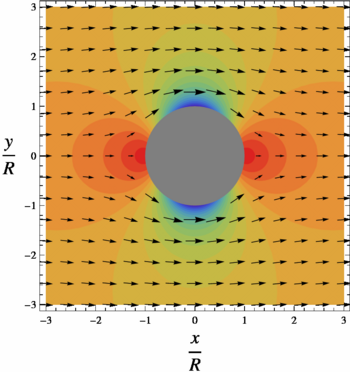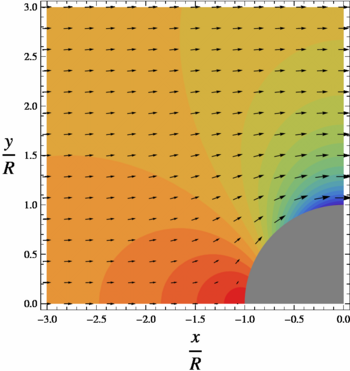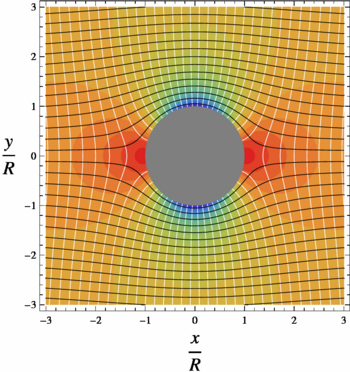Fluid flow past a cylinder: Difference between revisions
imported>Brian Fiedler |
imported>Brian Fiedler No edit summary |
||
| Line 40: | Line 40: | ||
The flow being incompressible, a [http://en.wikipedia.org/wiki/Stream_function stream function] can be found such that | The flow being incompressible, a [http://en.wikipedia.org/wiki/Stream_function stream function] can be found such that | ||
:<math>\vec{V}=\nabla\psi \times \widehat{k}</math> | :<math>\vec{V}=\nabla\psi \times \widehat{k}</math> | ||
It follows from this definition, using | It follows from this definition, using vector identities, | ||
:<math>\vec{V}\cdot\nabla{\psi}=0</math> | :<math>\vec{V}\cdot\nabla{\psi}=0</math> | ||
Therefore a contour of a constant value of <math>\psi</math> will also be a | Therefore a contour of a constant value of <math>\psi</math> will also be a stream line, a line tangent to <math>\vec{V}</math>. For the flow past a cylinder, we find: | ||
:<math> \psi= U \left( r - \frac{R^2}{r} \right) \cos\theta </math> | :<math> \psi= U \left( r - \frac{R^2}{r} \right) \cos\theta </math> | ||
| Line 48: | Line 48: | ||
== Comparison with flow of a real fluid past a cylinder == | == Comparison with flow of a real fluid past a cylinder == | ||
This symmetry of this ideal solution has the peculiar property of having zero net drag on the cylinder, a property known as D'Alembert's paradox. | |||
Unlike an ideal inviscid fluid, a viscous flow past a cylinder, no matter how small the viscosity, will acquire vorticity in a thin boundary layer adjacent to the cylinder. Boundary layer separation can occur, and a trailing wake will occur behind the cylinder. The pressure will be lower on the wake side of | |||
the cylinder, than on the upstream side, resulting in a drag force in the downstream direction. | |||
==References== | ==References== | ||
<references /> | <references /> | ||
==External Links== | |||
* [http://en.wikipedia.org/wiki/Stream_function stream function] | |||
* [http://en.wikipedia.org/wiki/Potential_flow potenial flow] | |||
* [http://en.wikipedia.org/wiki/List_of_vector_identities vector identities] | |||
* [http://en.wikipedia.org/wiki/Streamlines,_streaklines,_and_pathlines streamlines, streaklines and pathlines] | |||
* [http://en.wikipedia.org/wiki/D%27Alembert%27s_paradox D'Alembert's paradox] | |||
Revision as of 12:17, 30 May 2009
"The flow of an incompressible fluid past a cylinder is one of the first mathematical models that a student of fluid dynamics encounters. This flow is an excellent vehicle for the study of concepts that will be encountered numerous times in mathematical physics, such as vector fields, coordinate transformations, and most important, the physical interpretation of mathematical results." [1]
Mathematical solution
A cylinder (or disk) of radius is placed in two-dimensional, incompressible, inviscid flow. The goal is to find the steady velocity vector and pressure in a plane, subject to the condition that far from the cylinder the velocity vector is
where is a constant, and at the boundary of the cylinder
where is vector normal to the cylinder surface. The upstream flow is uniform and has no vorticity. The flow is inviscid, incompressible and has constant mass density . The flow therefore remains without vorticity, or is said to be irrotational, with everywhere. Being irrotational, there must exist a velocity potential :
Being incompressible, , so must satisify Laplace's equation:
The solution for is obtained most easily in polar coordinates and , related to conventional Cartesian coordinates by and . In polar coordinates, Laplace's equation is:
The solution that satisfies the boundary conditions is
The velocity components in polar coordinates are obtained from the components of in polar coordinates:
and
Being invisicid and irrotational, Bernoulli's equation allows the solution for pressure field to be obtained directly form the velocity field:
where the constants and appear to that far from the cylinder, where . Using ,
In the figures, the colorized field referred to as "pressure" is a plot of
On the surface of the cylinder, or , pressure varies from a maximum of 1 (red color) at the stagnation points at and to a minimum of -3 (purple) on the sides of the cylinder at and . Likewise, varies from V=0 at the stagnation points to on the sides, in the low pressure.
Stream function
The flow being incompressible, a stream function can be found such that
It follows from this definition, using vector identities,
Therefore a contour of a constant value of will also be a stream line, a line tangent to . For the flow past a cylinder, we find:
Physical interpretation
Comparison with flow of a real fluid past a cylinder
This symmetry of this ideal solution has the peculiar property of having zero net drag on the cylinder, a property known as D'Alembert's paradox. Unlike an ideal inviscid fluid, a viscous flow past a cylinder, no matter how small the viscosity, will acquire vorticity in a thin boundary layer adjacent to the cylinder. Boundary layer separation can occur, and a trailing wake will occur behind the cylinder. The pressure will be lower on the wake side of the cylinder, than on the upstream side, resulting in a drag force in the downstream direction.











































